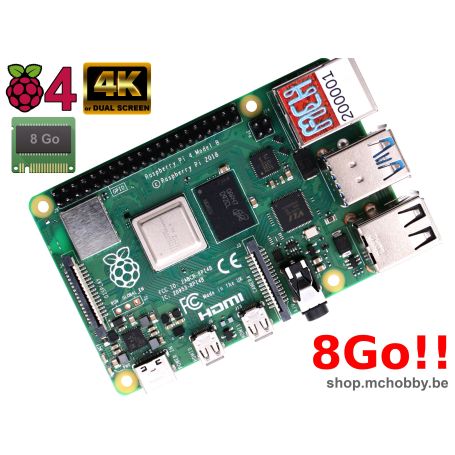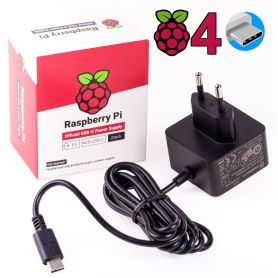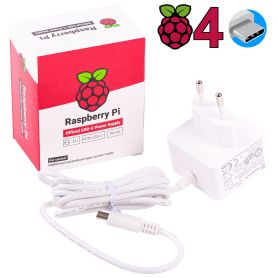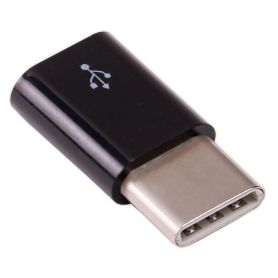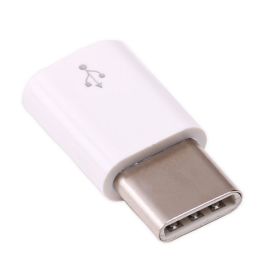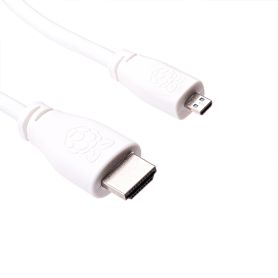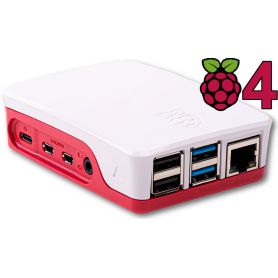Raspberry Pi 4 - 8 Go de RAM !! SALES ON STOCK !!
The Raspberry Pi 4 - model B
- 2x HDMI 4K
- 4 cores 1.8 Ghz (ARMv8)
- 8 Giga of RAM.
- Wifi 2.4 & 5 Ghz
- Bluetooth 5.0
- Ethernet Gigabit (900 Mb/s)
- 2x USB 3.0
- 2x USB 2.0
- PoE ready
- GPIO 40 pins
Payments are secured by LyraCollect, a French payment collection company.
It is possible to delivered to your home, to a pick-up point or picked up by appointment at MCHobby
We prepare, pack and ship your orders with great respect and care.
The Raspberry-pi 4 - 8Gb RAM, the great revolution in the world of nano-computers
This would happens a day or another, here is the Raspberry-Pi 4 fit with 8 Go de RAM.
Raspberry-Pi 4 was a major technical update in the nano-computer board world with an memory going up to 4 Go! With 8 Gb RAM version, the applications for this nano computer are even bigger.
What is the interest for this new 8Gb RAM version:
- Better experience while browing the web.
Internet is consuming more and more ressources on computer (quite more than the operating system). - Retro-gamer will love it... high tech emulator need lot of RAM to work.
- Create small entreprise server thank to the USB3 and Gigabit Ethernet.
Maintining and PostgreSQL DB on a Pi 4 can now be seriously consider. - The USB Boot can also be used to get RID of the SD card and having a really powerful computing system.
This version is now fit with 8 Go of RAM.
The new features of the Pi 4
The most obvious is still the new connectivity related to the various features.

Of the 4K finally... waited for a long time but finally possible! And more, the 4K is available on two HDMI ports! Yes, the Raspberry-Pi 4 now supports two screens. It should be noted a small nuance, the 4Kp60 is available on only one monitor but the 4Kp30 will be available on two monitors. The knowledgeable user will know that this only applies to demanding video installations :-)
 1, 2, 4 or 8Gb of RAM! The Raspberry-Pi 4 is available in several versions! But why different sizes of RAM? Well, for reasons of price and application! An audio system will not need more than 1Gb, as well as embedded applications. The 1Gb Pi 3model has also demonstrated great stability in multimedia center applications. Applications in 4K will go more to the 2 and 4Gb models, indeed the VideoCore can be configured to use between 0 and 4Gb of RAM. The 2Gb model can also be suitable for more resource-intensive applications (eg Jeedom and its MySQL motor). The 4Gb model is reserved for Web browsing (very greedy in memory) ans gluttonous applications in resources (4K, office automation, PC type).
1, 2, 4 or 8Gb of RAM! The Raspberry-Pi 4 is available in several versions! But why different sizes of RAM? Well, for reasons of price and application! An audio system will not need more than 1Gb, as well as embedded applications. The 1Gb Pi 3model has also demonstrated great stability in multimedia center applications. Applications in 4K will go more to the 2 and 4Gb models, indeed the VideoCore can be configured to use between 0 and 4Gb of RAM. The 2Gb model can also be suitable for more resource-intensive applications (eg Jeedom and its MySQL motor). The 4Gb model is reserved for Web browsing (very greedy in memory) ans gluttonous applications in resources (4K, office automation, PC type).
RAM LPPDR4, this information, however innocuous is very important. Indeed, the DDR4 uses a 2.4Ghz bus while the Pi 3 used a 900Mhz bus. The bandwidth to the memory is seriously enlarged!
 USB 3.0 Super Speed : finished the old USB stack that also managed the Ethernet support. This time, we have a real USB 3 controller from Via (a specialist in the field). The Pi 4 has two USB 3 ports and two USB 2.0 ports (downgrade to USB 2.0 for technical reasons). The USB 3 port has also been tested at 350 Mb/s with an SSD. According to the information in our possession, it is possible to boot on the USB 3.0.
USB 3.0 Super Speed : finished the old USB stack that also managed the Ethernet support. This time, we have a real USB 3 controller from Via (a specialist in the field). The Pi 4 has two USB 3 ports and two USB 2.0 ports (downgrade to USB 2.0 for technical reasons). The USB 3 port has also been tested at 350 Mb/s with an SSD. According to the information in our possession, it is possible to boot on the USB 3.0.
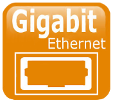 Ethernet Gigabit : As long as you eliminate the old USB stack, the Foundation has added a real Ethernet controller and in Gigabyte please. The network transfer has also been tested at 900 Mb/s by the Foundation's development team.
Ethernet Gigabit : As long as you eliminate the old USB stack, the Foundation has added a real Ethernet controller and in Gigabyte please. The network transfer has also been tested at 900 Mb/s by the Foundation's development team.
Boardcom Processor 2711 @ 1.8 Ghz : always with 4 cores and if the frequency of the clock increases by only 100Mhz, it is especially the processor architecture which makes a good one. By switching from Cortex A53 to Cortex A72, the processor is able to process more instructions per clock cycle. According to the Foundation, this substantial gain in performance is felt up to the application level.
The Pi 4 PCIe bus : the real hidden revolution of Pi 4. It will go almost unnoticed but it is nevertheless there! Exit the USB bus to transfer data to the USB + Ethernet stack of Pi 3 and previous models. The Pi 4 has a PCIe bus (PCI Express) second generation Gen2 1x. Thus, even at full rate, a USB 3 connection can't saturate the PCIe bus. Exchanges of information with USB peripherals will finally be able to reach a descent rate and an interesting reliability!
Still no Sata or MSata connector? Frankly it doesn't matter! With USB 3 and a PCIe backbone bus, a whole series of applications and performant interfaces can be envisaged!
What doesn't change
WiFi and Bluetooth : the very popular WiFi solution appeared Pi 3 and the funnel antenna Pi Zero W are of course available on the Pi 4. WiFi in 2.4Ghz and 5Ghz. Note that Bluetooth 5.0 is making its appearance.
Micro SD card : to store the operating system and user data. Note that the Pi boot sequence is still able to support the USB boot. Rate enhanced by Mode50 support.
DSI and CSI port : the camera and display ports are indicated as retro-compatible.
GPIO 40 pins : guaranteed retro-compatible with the Pi 3. It brings some improvements (see below).
Poe Ready : the Pi 4 has the PoE connector behind the Ethernet port. This progress of Pi 3 remains in place for Pi 4.
Passive cooling : like the Pi 3, the board is designed to evacuate some of the heat through the copper tracks of the board.
The supply circuit : always identical and sometimes the source of problems (remaining largely negligible). This one would have been the subject of a careful revision but on the bottom, it doesn't change.
.png)
The results
These crisp novelties don't come without some small inconveniences.
The form factor : there are new connectors and the form factor is therefore significantly modified. The main elements (USB, Ethernet, SD, GPIO, ...) and fixing holes seem to be positioned identically. Modifications on the case should remain minor. So there is a new official case for the Pi 4.
USB C power supply : the power connector switches from micro USB to USB type C, which allows to pass the 3 Amps required by the platform. So there are two new power supplies with USB Type C connector in white and in black.
micro HDMI : placing two standard HDMI ports on the Form Factor Pi 4 is not an option. The Raspberry-Pi Foundation has therefore opted for micro HDMI connectors. It will therefore have a micro HDMI to HDMI convertor.
Attention, this one is different from the Pi Zero which exposes a Mini HDMI.
4K and heat dissipation
At MC Hobby, we know that 4K operation dissipates much more heat than most nano-computers. 4K Nano-computers also have coolers of generally impressive size.
So we looked at the subject and asked the Foundation about it because there is no recommendation on the subject, or point of inking on the Pi.
According to the Foundation, dissipation by the board fully fulfills its function. The throttling (reduction of the processor frequency when the temperature reaches 85°C) also allows to maintain correct performances without disturbing overheating and excessive clamping of the platform.
The foundation also specify that a cooler (or Hat PoE fan) would be welcome anyway.. but not essential.
For us, the makers, because we are worth it!
The Pi 4 still has a 40-pin GPIO retro-compatible with the Pi 3. There are however some interesting advances for the makers in electronic.
To start, the speed of the serial port is no longer dependent on the clock speed of the processor (dixit: the Foundation). There is also the possibility of having 4 UARTS on the GPIO. No more problem to coexist modems, GPS and serial interfaces.
- GPIO 0-3 = UART2 TXD, RXD, CTS, RTS
- GPIO 4-7 = UART3 TXD, RXD, CTS, RTS
- GPIO 8-11 = UART4 TXD, RXD, CTS, RTS
- GPIO 12-15 = UART5 TXD, RXD, CTS, RTS
Note that UART5 is available on GPIOs 14 & 15 but for CTS/RTS signals (not for TXD and RXD).
The PWM signals of the GPIO are now independent of the PWM signals of the audio output (on the 4-pin connector). So it is possible to simultaneously use the PWM of the GPIO and the PWM audio output!
Note that the audio output now has a separate power rail (see Foundation), which should improve the output quality. It is also possible to use this montage to significantly improve the quality of the PWM audio output.
Content
For each order you'll receive a Raspberry-Pi 4 model B with 8 Go of RAM.
This product can't work alone, the following items will be required to operate the Raspberry-Pi:
- A 3 amp USB C power supply (also available in black) or a micro USB-USB-C white / black convertor
- A micro HDMI to HDMI connector
- A micro SD card of 16 Go , 32 Go or a Noobs operating system ready-to-use
- Keyboard and mouse will be welcome
Legal documents
- Raspberry Compatibility
- Pi 4
- CPU RAM
- 8 GB
- CPU Frequency
- 1.8 GHz
- WiFi
- YES
- Ethernet
- Gigabit
- Bluetooth
- BLE 5.0

